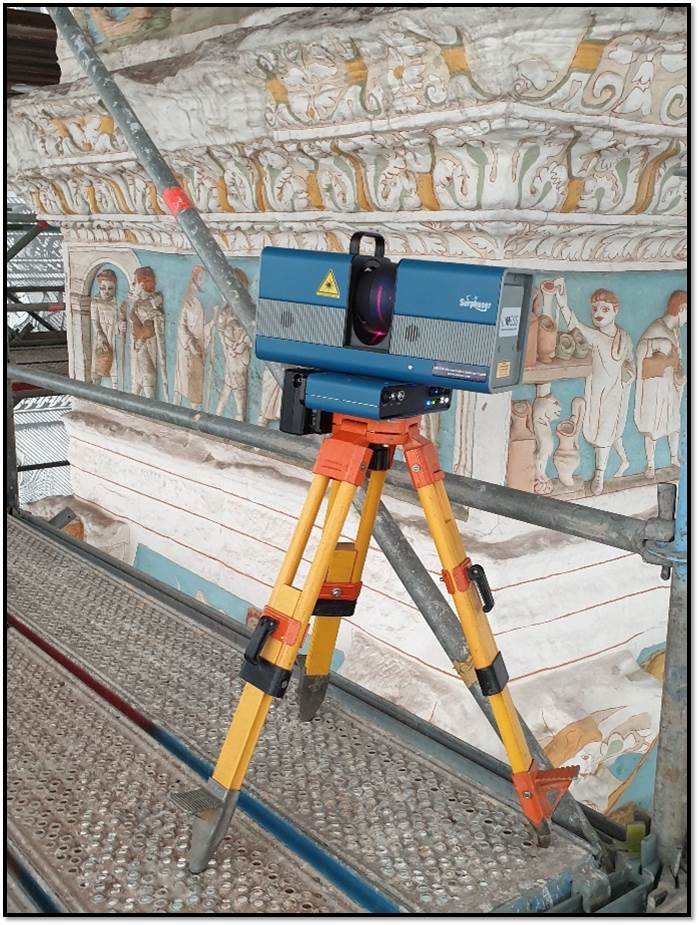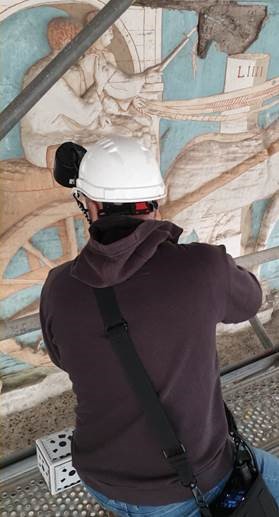Igel Column
The 22.5m high pillar monument of the Igel Column is one of the most famous Roman pillar monuments in Germany (Igel a.d. Mosel). The funerary monument was erected around 250 AD by the brothers Lucius Secundinius Aventinus and Lucius Secundinius Securus. It is richly decorated with reliefs depicting, among other things, scenes from the everyday and professional life of the cloth merchants, as well as from mythology. In addition to commemorating the dead of the family, the monument probably also had the purpose of advertising the Secundinians’ cloth business in Roman Trier.
A true-to-original copy of this column with a reconstructed color scheme (1993), which was still molded in Kaiser’s time (1907), was located in the Rheinisches Landesmuseum in Trier. This column, which is an UNESCO World Heritage Site, was already documented in three dimensions by ArcTron in 2012. The concrete copy shows more details than the original in Igel, which is more exposed to weathering. The poor state of preservation and the constant need for securing and conservation measures led to the decision to replace the replica from 1907/08 with a new cast, creating thus a new replica.
As part of these two projects “digital conservation” and “new column replica”, ArcTron 3D was again commissioned to capture and evaluate the column in 3D. Only this time in extremely high resolution in the sub-mm range using the latest technology, and finally to digitally prepare the individual parts for subsequent 3D printing on a scale of 1:1.
Since the entire process, from 3D measurement to 3D printing, is at the limits of what is currently technically possible, it can also be referred to as a “technological lighthouse project”.
3D Measurement On Site
The scans were carried out with a sensor combination using also the world’s currently most accurate sub-mm laser scanner (Surphaser) and close-range photogrammetry “stabilized” by precisely measured reference marks. On site, there was a realization window of only 2 weeks, during which work was carried out continuously on site. In the summer of 2021, weather conditions were sometimes very problematic, so that work had to be interrupted several times during thunderstorms, torrential rain and strong gales. Thanks to the many years of experience and efficient workflows of the surveying team, however, all work was completed within the specified time window.
3D Data Processing
The as-built documentation resulted in over 14,000 photogrammetry images as well as 3D laser scan images taken from over 400 viewpoints. To ensure color accuracy, color maps were used for all images, and the color of the RAW images was adjusted accordingly at the beginning of the processing work. After fusing of all data as well as mesh and color correction, an extremely high-resolution 3D model of the Igel column was created.
RAW Model:
HQ Model:
Point Cloud:
The Igel Column as an interactive model. A “technological lighthouse” – the perfect fusion of antiquity and modernity, ready for printing on a scale of 1:1 (here in extremely reduced quality).
Preparation of the Print Data
For the 3D printing of the replica on a scale of 1:1 designed by the project management, the one-piece overall model first had to be divided into a total of 33 high-resolution vertical zone segments. For each one, a so-called internal space model was then generated by extruding the segment surfaces inward to a wall thickness of 26cm. The final segments created in this way were compared with the original overall model for checking purposes and, if necessary, corrections were incorporated to ensure a coherent 3D model later on. In this process, the 3D programs sometimes reached their technical limits.
Subsequently, the individual stones were segmented from the processed zones and the solid body of the respective stone was formed. This resulted in a total of 240 stones, which will now serve as the basis for the 3D-printed casting molds of the replica stones. Regular quality assurance had the highest priority at all times and was meticulously documented.
Experience the legacy of the Roman Trier clothiers Secundinier, presented with 21st century precision and technology. View the digital Igel Column and prepare for a breathtaking journey through time.
Our special thanks go to all project participants, especially to the Landesbetrieb Liegenschafts- und Baubetreuung (LBB) Trier with the architect Mrs. Basten and the cathedral architect and project coordinator Dr. Hauck (conceptm) for the intensive and constructive cooperation!
- Client
- LANDESBETRIEB LIEGENSCHAFTS- UND BAUBETREUUNG Niederlassung Trier
- Content
- 3D laser scanning, photogrammetry, 3D printing data
- Related references
- Walhalla
- Karlskirche Vienna
- Tags

